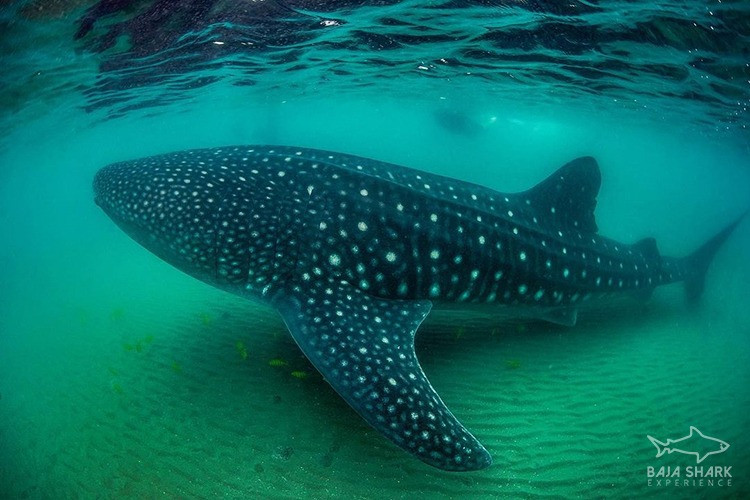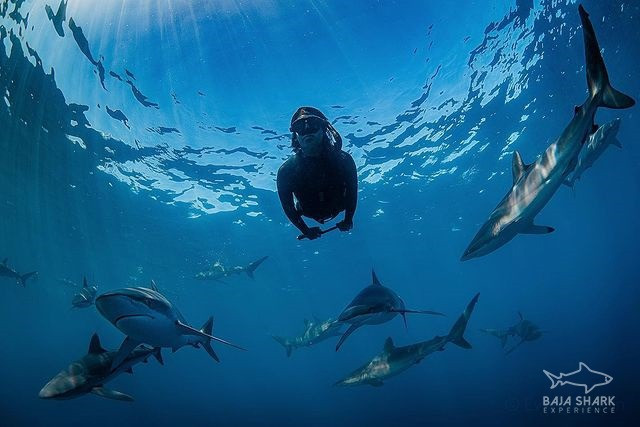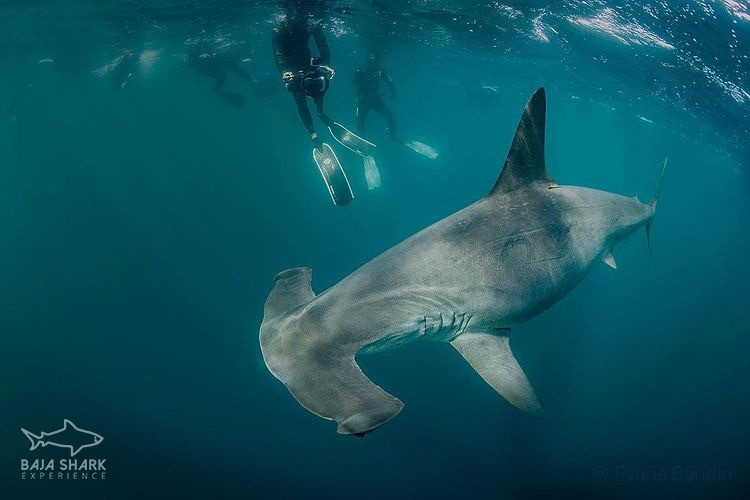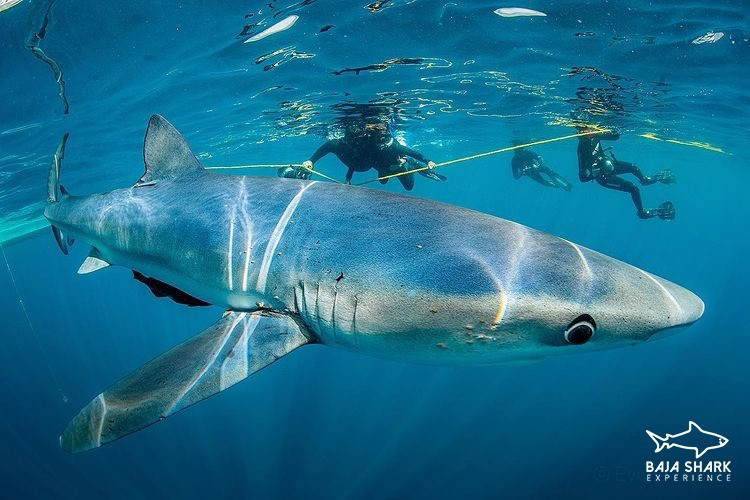Are there sharks in Cabo San Lucas, Mexico, especially for LGBTQ+ travelers seeking adventure? Absolutely, Cabo San Lucas is home to a diverse range of shark species. Gaymexico.net is your ultimate resource for exploring this thrilling aspect of Cabo, ensuring a safe and unforgettable experience while providing essential insights for LGBTQ+ travelers. Discover the best spots for shark encounters, understand the local marine life, and plan your trip with our expert guidance. Whether you’re interested in eco-tourism, wildlife tours, or the best LGBTQ+ friendly activities, gaymexico.net has you covered with travel tips and community insights.
1. What Sharks Can You Find in Cabo San Lucas?
Yes, several shark species inhabit the waters around Cabo San Lucas, making it a prime location for shark enthusiasts. Cabo San Lucas boasts a rich marine ecosystem, attracting several shark species. From the majestic whale shark to the swift mako shark, the waters here offer incredible opportunities for divers and nature lovers.
Here’s a breakdown of some common sharks you might encounter:
- Whale Sharks (Rhincodon typus): These gentle giants are filter feeders and completely harmless to humans.
- Hammerhead Sharks (Sphyrna lewini, Sphyrna zygaena): Recognizable by their unique head shape.
- Silky Sharks (Carcharhinus falciformis): Known for their smooth skin, often seen in bait balls.
- Mako Sharks (Isurus oxyrinchus): One of the fastest shark species.
- Blue Sharks (Prionace glauca): Identified by their beautiful blue coloration.
- Bull Sharks (Carcharhinus leucas): Adaptable sharks that can tolerate both saltwater and freshwater.
 Whale Shark Cabo San Lucas
Whale Shark Cabo San Lucas
2. Is It Safe to Swim in Cabo San Lucas?
Swimming in Cabo San Lucas is generally safe, but awareness and caution are key, especially in areas where sharks are known to frequent. Cabo San Lucas is generally a safe destination for swimming and water activities. However, like any coastal area, it’s important to be aware of the presence of marine life, including sharks.
Here are some safety tips to keep in mind:
- Swim in Designated Areas: Stick to beaches and areas that are patrolled by lifeguards.
- Heed Warnings: Pay attention to any warnings or advisories about shark activity.
- Avoid Swimming at Dawn and Dusk: These are peak feeding times for many shark species.
- Don’t Wear Shiny Jewelry: Shiny objects can resemble fish scales and attract sharks.
- Avoid Swimming with Open Wounds: Sharks have a strong sense of smell and can detect blood from a distance.
- Use Reputable Tour Operators: When participating in shark diving or snorkeling tours, choose experienced and certified operators.
3. Where Can You Swim with Sharks in Cabo San Lucas?
The best place to swim with sharks near Cabo San Lucas is typically in La Paz, where whale shark encounters are common. Swimming with sharks is a thrilling experience, and Cabo San Lucas offers several options for safe and responsible encounters.
- Whale Shark Tours in La Paz: La Paz, located a few hours from Cabo, is a popular spot for swimming with whale sharks. Numerous tour operators offer guided excursions to these gentle giants.
- Shark Diving Tours: Some operators offer diving tours to observe other shark species, such as hammerheads and silky sharks. These tours often take place in open ocean environments.
- Cabo Pulmo National Park: This protected marine area is home to a variety of marine life, including bull sharks. Diving and snorkeling tours are available.
 Swimming with Whale Shark
Swimming with Whale Shark
4. When Is Shark Season in Cabo San Lucas?
Shark sightings vary by species, but generally, the cooler months (October to April) are best for whale sharks, while summer months see more hammerheads and silky sharks. Different shark species have different migration patterns and seasonal behaviors.
Here’s a general guide to when you might see certain shark species in Cabo San Lucas:
- Whale Sharks: October to April
- Hammerhead Sharks: January to August
- Silky Sharks: June to January
- Mako Sharks: December to June
- Blue Sharks: December to April
- Bull Sharks: Year-round in Cabo Pulmo
5. What Safety Measures Are in Place for Shark Tours?
Reputable tour operators prioritize safety with experienced guides, proper equipment, and strict protocols to ensure responsible interactions with sharks. Safety is paramount when it comes to shark tours. Reputable tour operators follow strict guidelines and protocols to ensure the safety of both participants and the sharks.
- Experienced Guides: Tours are led by certified and experienced guides who are knowledgeable about shark behavior and safety procedures.
- Proper Equipment: Participants are provided with appropriate snorkeling or diving gear, including wetsuits, masks, and fins.
- Safety Briefings: Before the tour, participants receive a detailed safety briefing that covers the dos and don’ts of interacting with sharks.
- Controlled Environments: Tours often take place in areas with good visibility and minimal currents to ensure a safe and comfortable experience.
- Respectful Interactions: Tour operators emphasize the importance of respecting the sharks and their environment. Participants are instructed to maintain a safe distance and avoid any behavior that could disturb or harm the animals.
6. Are Shark Attacks Common in Cabo San Lucas?
Shark attacks are rare in Cabo San Lucas. The region’s focus on eco-tourism and regulated shark encounters contributes to a safe environment for both tourists and marine life. While the presence of sharks might raise concerns about potential attacks, it’s important to note that shark attacks are extremely rare in Cabo San Lucas.
According to the International Shark Attack File (ISAF), the risk of being attacked by a shark is very low. Most sharks are not interested in humans as prey, and attacks typically occur due to mistaken identity or defensive behavior.
7. What Should LGBTQ+ Travelers Know About Safety in Cabo San Lucas?
Cabo San Lucas is generally a welcoming destination for LGBTQ+ travelers, but it’s wise to stay informed and connected with community resources. Cabo San Lucas is increasingly recognized as a welcoming destination for LGBTQ+ travelers. However, like any travel destination, it’s essential to be aware of local customs and take necessary safety precautions.
Here are some tips for LGBTQ+ travelers visiting Cabo San Lucas:
- Research LGBTQ+ Friendly Venues: Identify and support businesses that are known to be welcoming and inclusive.
- Stay Informed: Keep up-to-date on local laws and attitudes towards LGBTQ+ individuals.
- Connect with Local Resources: Reach out to LGBTQ+ organizations or community centers for information and support.
- Be Aware of Public Displays of Affection: While Cabo San Lucas is generally tolerant, public displays of affection might attract unwanted attention in certain areas.
- Trust Your Instincts: If you feel uncomfortable or unsafe in a particular situation, remove yourself from the situation and seek assistance.
Gaymexico.net offers resources and information to help LGBTQ+ travelers plan safe and enjoyable trips to Mexico.
Address: 3255 Wilshire Blvd, Los Angeles, CA 90010, United States.
Phone: +1 (213) 380-2177
Website: gaymexico.net.
8. How Does Eco-Tourism Impact Shark Conservation in Cabo?
Eco-tourism helps fund conservation efforts and promotes responsible interactions with sharks, contributing to their protection in Cabo’s waters. Eco-tourism plays a vital role in shark conservation in Cabo San Lucas. By promoting responsible interactions with sharks and their environment, eco-tourism helps raise awareness about the importance of shark conservation.
Here are some ways eco-tourism contributes to shark conservation:
- Funding for Research and Conservation: Tour operators often contribute a portion of their profits to shark research and conservation efforts.
- Education and Awareness: Eco-tourism tours provide opportunities to educate participants about shark biology, behavior, and conservation.
- Economic Incentives: Eco-tourism creates economic incentives for local communities to protect sharks and their habitats.
- Advocacy: Eco-tourism operators can advocate for stronger shark conservation policies and regulations.
9. What Role Does Gaymexico.net Play in Promoting Safe Travel?
Gaymexico.net provides reliable information and resources for LGBTQ+ travelers, ensuring safe and enjoyable experiences in Mexico, including Cabo San Lucas. Gaymexico.net is committed to promoting safe and responsible travel for LGBTQ+ individuals in Mexico. The website provides a wealth of information and resources to help travelers plan their trips and stay informed about local conditions.
Gaymexico.net offers:
- Travel Guides: Detailed guides to LGBTQ+ friendly destinations in Mexico, including Cabo San Lucas.
- Safety Tips: Practical advice on how to stay safe and avoid potential risks.
- Community Resources: Information on LGBTQ+ organizations and support groups in Mexico.
- News and Updates: Coverage of LGBTQ+ issues and events in Mexico.
By providing reliable information and resources, Gaymexico.net empowers LGBTQ+ travelers to make informed decisions and enjoy safe and fulfilling experiences in Mexico.
10. How Can You Ensure a Responsible Shark Encounter?
Choose tour operators that follow ethical guidelines, respect shark behavior, and prioritize the animal’s well-being over tourist thrills. To ensure a responsible shark encounter, it’s essential to choose tour operators that prioritize the well-being of the sharks and their environment.
Here are some guidelines for responsible shark encounters:
- Choose Certified Operators: Select tour operators that are certified by reputable organizations and follow ethical guidelines.
- Respect Shark Behavior: Maintain a safe distance from the sharks and avoid any behavior that could disturb or harm them.
- Avoid Feeding Sharks: Feeding sharks can alter their natural behavior and make them more dependent on humans.
- Don’t Use Flash Photography: Flash photography can startle or disorient sharks.
- Support Conservation Efforts: Choose tour operators that contribute to shark research and conservation.
 Hammerhead Shark Cabo San Lucas
Hammerhead Shark Cabo San Lucas
11. Are There Specific Laws Protecting Sharks in Mexico?
Yes, Mexico has laws protecting certain shark species, and these regulations help ensure sustainable tourism and conservation efforts. Mexico has taken significant steps to protect sharks and promote sustainable fishing practices.
Some of the key laws and regulations include:
- Protected Species: Certain shark species, such as the whale shark and great white shark, are protected under Mexican law. It is illegal to hunt, capture, or harm these species.
- Fishing Regulations: The Mexican government regulates shark fishing through quotas, permits, and seasonal closures. These regulations aim to prevent overfishing and ensure the long-term sustainability of shark populations.
- Marine Protected Areas: Mexico has established numerous marine protected areas, such as Cabo Pulmo National Park, where shark fishing is prohibited or restricted.
- International Agreements: Mexico is a party to international agreements, such as the Convention on International Trade in Endangered Species (CITES), which regulates the trade of certain shark species.
12. What Are the Best Times for Water Visibility in Cabo San Lucas?
Water visibility in Cabo San Lucas is typically best during the dry season (November to May), which enhances the shark viewing experience. Water visibility is an important factor to consider when planning a shark encounter. Good visibility allows for better viewing and photography opportunities.
The best time for water visibility in Cabo San Lucas is typically during the dry season, which runs from November to May. During this time, the weather is generally sunny and dry, with little rainfall. The lack of rain runoff results in clearer water conditions.
13. How Does Climate Change Affect Shark Populations in Cabo?
Climate change impacts water temperatures and prey availability, potentially affecting shark migration patterns and overall health in the Cabo region. Climate change is a global threat that affects marine ecosystems, including shark populations.
Here are some ways climate change can impact shark populations in Cabo San Lucas:
- Rising Water Temperatures: Warmer water temperatures can alter shark migration patterns and reduce the availability of prey species.
- Ocean Acidification: Increased levels of carbon dioxide in the atmosphere can lead to ocean acidification, which can harm marine life, including sharks.
- Sea Level Rise: Rising sea levels can inundate coastal habitats and disrupt shark breeding and feeding grounds.
- Extreme Weather Events: More frequent and intense storms can damage coral reefs and other marine habitats, impacting shark populations.
14. What Gear Do You Need for Shark Snorkeling or Diving?
Essential gear includes a well-fitting wetsuit, mask, snorkel (for snorkeling), fins, and potentially a dive computer (for diving). For shark snorkeling or diving, it’s essential to have the right gear to ensure your safety and comfort.
Here’s a list of essential gear:
- Wetsuit: A wetsuit will help keep you warm in the water. The thickness of the wetsuit will depend on the water temperature.
- Mask: A well-fitting mask is essential for clear underwater vision.
- Snorkel: A snorkel allows you to breathe while floating on the surface of the water (for snorkeling).
- Fins: Fins will help you propel yourself through the water with ease.
- Dive Computer: A dive computer monitors your depth, time, and other important information (for diving).
- Dive Gear (for diving): For diving, you will also need a buoyancy compensator (BCD), regulator, and dive tank.
15. What Alternatives Are There to Shark Cage Diving in Cabo?
Alternatives to shark cage diving include snorkeling with whale sharks, free diving, and simply observing sharks from a safe distance on a boat tour. While shark cage diving can be an exciting experience, it’s not for everyone. Fortunately, there are several alternatives to shark cage diving that allow you to observe sharks in a safe and responsible manner.
Here are some alternatives:
- Snorkeling with Whale Sharks: Snorkeling with whale sharks is a popular and ethical way to encounter these gentle giants.
- Free Diving: Free diving allows you to get up close and personal with sharks without the need for scuba gear.
- Boat Tours: Many tour operators offer boat tours that allow you to observe sharks from a safe distance.
16. How Can Tourists Contribute to Shark Research in Cabo?
Tourists can support shark research by participating in citizen science programs, donating to research organizations, and choosing eco-friendly tour operators. Tourists can play an active role in contributing to shark research and conservation efforts in Cabo San Lucas.
Here are some ways tourists can get involved:
- Participate in Citizen Science Programs: Some research organizations offer citizen science programs that allow tourists to collect data on shark sightings, behavior, and other information.
- Donate to Research Organizations: Consider donating to organizations that are dedicated to shark research and conservation.
- Choose Eco-Friendly Tour Operators: Support tour operators that prioritize shark conservation and follow ethical guidelines.
- Report Shark Sightings: If you see a shark while swimming, snorkeling, or diving, report the sighting to local authorities or research organizations.
- Spread Awareness: Share your knowledge and experiences with others to raise awareness about the importance of shark conservation.
 Blue Shark Baja California
Blue Shark Baja California
17. What Is the Cultural Significance of Sharks in Mexico?
In some indigenous cultures, sharks are revered as powerful symbols, while in modern Mexico, they are increasingly recognized for their ecological importance. Sharks hold a complex cultural significance in Mexico. In some indigenous cultures, sharks are revered as powerful symbols of strength and resilience. In modern Mexico, there is a growing awareness of the ecological importance of sharks and the need to protect them.
18. Are There Any Shark Sanctuaries Near Cabo San Lucas?
While there isn’t a designated shark sanctuary directly in Cabo San Lucas, the broader region includes protected marine areas that benefit shark populations. While there isn’t a specific shark sanctuary located directly in Cabo San Lucas, the broader region includes several protected marine areas that benefit shark populations.
Some of these areas include:
- Cabo Pulmo National Park: This protected area is home to a variety of marine life, including bull sharks.
- Baja California Sur Biosphere Reserve: This reserve encompasses a vast area of land and sea and includes important shark habitats.
19. What are the Long-Term Projections for Shark Populations?
Long-term projections depend on conservation efforts, climate change mitigation, and sustainable fishing practices to ensure healthy shark populations. The long-term projections for shark populations in Cabo San Lucas and around the world depend on a variety of factors, including conservation efforts, climate change mitigation, and sustainable fishing practices.
According to the International Union for Conservation of Nature (IUCN), many shark species are threatened with extinction due to overfishing, habitat destruction, and other factors. However, there is also growing awareness of the importance of shark conservation, and efforts are underway to protect shark populations.
20. How Does Gaymexico.net Support Sustainable Tourism in Cabo?
Gaymexico.net promotes responsible travel by highlighting eco-friendly options, supporting local communities, and providing information on ethical wildlife encounters. Gaymexico.net is committed to supporting sustainable tourism in Cabo San Lucas and throughout Mexico. The website promotes responsible travel practices by highlighting eco-friendly options, supporting local communities, and providing information on ethical wildlife encounters.
By using Gaymexico.net, you’re not only planning an incredible trip, but you’re also contributing to a more sustainable and inclusive future for tourism in Mexico.
Ready to explore the wonders of Cabo San Lucas while supporting responsible and LGBTQ+ friendly tourism? Visit gaymexico.net today to discover more travel guides, connect with the community, and plan your next adventure!
